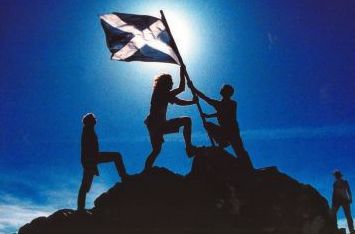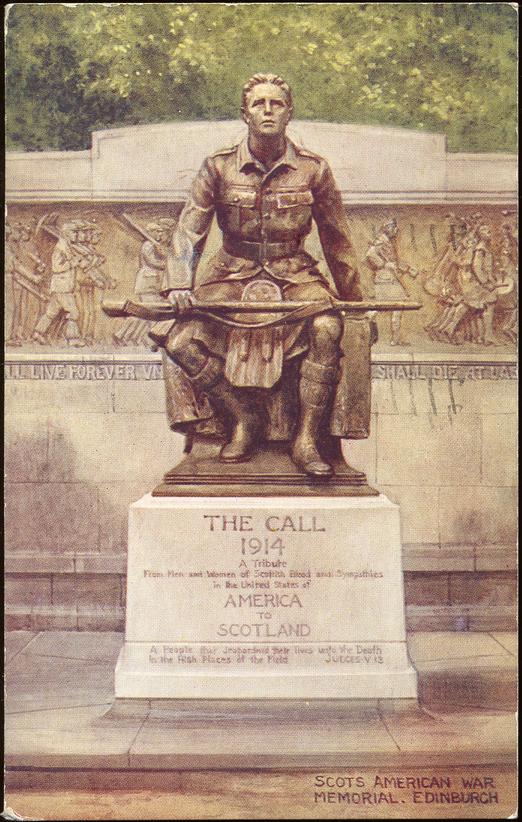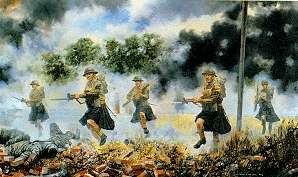"Those who do not remember the past are condemned to repeat it." ~ George Santayana
Some of you may have heard of a little fracas between the Scots and the English on the 23rd of June 1314 at a place called Bannockburn.

image source: Mid Calder Tap Shop Tartan Army. West Lothian Branch of the Tartan Army.
And stood against him,
Proud Edward's Army,
And sent him homeward,
Tae think again.
Well that didn't settle as much as one might of hoped!
By the beginning of the Twentieth Century the British Crown had learned to use the Scots as cannon fodder.
"the Scots were sent in first, then the Welsh, and finally the English."
The Scots were less than 12% of the United Kingdom population, yet suffered more than 25% of British casualties in World War I .
Average height of Scots before World War I was SIX feet.
World War I was a war without parallel - all previous wars were eclipsed by its scale of destruction. When the fighting was finally over, no-one could tell exactly how many had been killed but historians estimate that up to 10 million men lost their lives on the battlefield - and another 20 million were wounded. In the decade following the Great War many had the firm conviction that it should be "the war to end all wars".
news.bbc.co.uk/1/hi/special_report/1998/10/98/world_war_i/198172.stm
Conscription put into uniform nearly every physically fit man, six million out of ten million eligible in Britain. Of these, about 750,000 lost their lives and 1,700,000 were wounded. Most deaths were to young unmarried men; however, 160,000 wives lost husbands and 300,000 children lost fathers. [Havighurst p 134-5]
The optimism of the 1900s was entirely gone and those who fought in the war became what is known as "the Lost Generation" because they never fully recovered from their experiences. For the next few years, much of Europe began its mourning; memorials were erected in thousands of villages and towns. http://en.wikipedia.org/wiki/WWI
A hint at the tremendous cost of WWI to Scotland is "The Call" statue in the West end of Princes Street Gardens in Edinburgh. A few years after the Great War even the Americans were so moved by the disproportionate casualty rate of the Scottish Regiments that they raised £10,000 for this memorial.
The British Medical Journal of July 9th (1927) states that the exhibition was of special and timely interest to the medical profession as the annual meeting of the British Medical Association was this year held in Edinburgh; many of the main exhibits being studies and sketch models for the Scottish War Memorial to be a gift from America. The Journal goes on to say that the underlying idea of Professor Tait McKenzie's beautiful group was explained by the inscription upon the pedestal of the main figure -" 1914 - A tribute from men of Scottish blood and sympathies in America to Scotland." The memorial is to be carried out in bronze and Craigleith stone. It shows a kilted youth with his rifle across his knees, seated, but preparing to spring up to answer the call'to arms, in front of a frieze which forms the background of the memorial and depicts a procession of marching recruits headed by pipers. These figures, like all his work, are remarkable for their sense of action. Underneath is carved the legend: "If it be life that waits, I shall live forever unconquered. If death, I shall die at last, strong in my pride and free." A fine idea, finely executed. Source: Can Med Assoc J. 1927 September; 17(9): 1068--1071.

image source: chaucer.library.emory.edu/wwi/images/doublesize/the_call1.jpg
"The Call" Princes Street Gardens West in Edinburgh
Inscriptions: Front (south side) of statue: THE CALL 1914 A Tribute From Men and Women of Scottish Blood and Sympathies In the United States of AMERICA TO SCOTLAND A People that Jeoparded their Lives unto the Death in the High Places of the Field JUDGES - V - 18 Below the frieze (carved on the wall): IF IT BE LIFE THAT WAITS I SHALL LIVE FOREVER UNCONQUERED IF DEATH I SHALL DIE AT LAST STRONG IN MY PRIDE AND FREE
Signatures: On the back of the seated soldier, below his coat: R. Tait McKenzie 1923 - 27. Bronze relief signed bottom right corner: ROMAN BRONZE WORKS N-Y-. Inscription signed bottom right: A.E. MACINTOSH Bronze frieze signed bottom left: R.Tait McKenzie fecit. 1924 - 1927 Source: pmsa.cch.kcl.ac.uk/EH/EDIN0182.htm
America's touching tribute to Scotland's war dead
by
WILL SPRINGER (excerpt)
One of the most poignant war memorials in Britain, The Call was designed by R Tait McKenzie, a Canadian-born physician and artist of Scottish descent who was at the time a distinguished educator at the University of Pennsylvania in Philadelphia. The memorial, which cost £10,000 (or about £400,000 today), was a gift from American Scots as a tribute to the bravery of Scottish troops during the 1914-1918 conflict.
Directly behind the statue, a long bronze relief panel features men from all walks of life joining the call to arms, marching from left to right, with a pipe band leading the way. The Craigleith sandstone backdrop was designed by architect Reginald Fairlie. Along the base of the panel, a carved inscription reads: "If it be life that waits I shall live forever unconquered; if death I shall die at last strong in my pride and free." Source: heritage.scotsman.com Fri 26 May 2006
On Flanders Field in World War I
With bulging eyes the startled Hun
Saw screaming through the shot and shell
The feared and fearless LADIES FROM HELL.

image source: Lock Stock and Barrel
This is why you will find a '14 - '18 monument in virtually every Scottish village.
Average height of Scots after World War I, FIVE feet, NINE inches.
I do not mean to imply that the Scots have suffered more than anyone else, but we have paid dearly.
And Scottish soldiers continue to pay:
Lieutenant Richard Palmer
Captain Richard Holmes
Private Lee Ellis
L/Cpl Allan Douglas
Cpl Gordon Alexander Pritchard
Private Pita Tukatukawaqa
Sergeant Stuart Gray
Private Paul Lowe
Private Scott McArdle
Private Kevin McHale
Private Marc Ferns
Fusilier Gordon Gentle
Sapper Robert Thomson
Lance Corporal Andrew Craw
Fusilier Russell Beeston
Private Jason Smith
At this point I would like to remember a long lost friend, Jerry Pigeon. The times you have crossed my mind indicate to me a connection beyond our link as Vietnam Era veterans. This link became clear when I discovered a Pennsylvania artist, Robert Griffing.
Robert Griffing - Warriors

In this scene, a Cherokee warrior and highlander scout in advance of Grants disastrous expedition against Ft. Duquesne. Sadly, both cultures eventually crumbled beneath the oppressive weight of British expansion.
As the French and Indian War (1754–1763), the nine-year North American chapter of the Seven Years' War, exploded into a world wide struggle, Great Britain expanded its army in North America. Among the many units sent to The Americas were three Scottish regiments: first the 42nd Highland Regiment and later the 77th and 78th Highland Regiments. Throughout the war, English authorities negotiated with the Native Americans for their military assistance. While the English were not as skilled at romancing the Native Americans as their French counterparts, they did experience some success. This was partly due to the influence of the Highlanders.
Perhaps that's because the Native Americans saw in the Highlanders something very similar... themselves! Both cultures were consummate warriors and lovers of the fray. Their people had great respect for the orator and Chieftain. Clan and tribe held ancient traditions in high regard. Their similarities in temperament and philosophy did not escape the English. They sometimes referred to the Scots as "cousins to the Indian." ~ Paramount Press, Inc.
A connection that did the Scots no favours in the late 18th and early 19th centuries of "Western Civilisation".
"The extermination of the Highlanders has been carried on for many years as systematically and relentlessly as of the North American Indians." ~ Dr. D. G. F. Macdonald. [as cited by Mathilde Blind in The Heather on Fire (1886)]
This is why I support warriors where ever they are.
"War is an ugly thing, but not the ugliest of things. The decayed and degraded state of moral and patriotic feeling which thinks that nothing is worth war is much worse. A man who has nothing for which he is willing to fight, nothing which is more important than his own personal safety, is a miserable creature and has no chance of being free unless made and kept so by the exertions of better men than himself." ~ John Stuart Mill 1806-1873
Take note Jane, Bill, et al.
Russell M. Middleton, AB, USAF 1969 - 1973